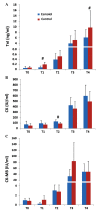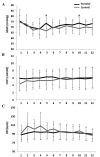A pilot study of perioperative esmolol for myocardial protection during on-pump cardiac surgery
- PMID: 27882105
- PMCID: PMC5103733
- DOI: 10.3892/etm.2016.3725
A pilot study of perioperative esmolol for myocardial protection during on-pump cardiac surgery
Abstract
The protective effects of preprocedural esmolol on myocardial injury and hemodynamics have not, to date, been investigated in patients who were scheduled for cardiac surgeries under a cardiopulmonary bypass (CPB). A pilot randomized controlled trial was performed at The First Affiliated Hospital of Dalian Medical University (Dalian, China). Patients scheduled for elective open-heart surgeries under CBP were included, and were randomized to esmolol and control groups. For patients in the esmolol groups, intravenous esmolol (70 µg/kg/min) was administered at the time of incision until CPB was performed. For patients assigned to the control group, equal volumes of 0.9% saline were administered. Markers of myocardial injury and hemodynamic parameters were observed until 12 h post surgery. A total of 24 patients were included in the present study. No significant differences in hemodynamic parameters, including the central venous pressure and heart rate, were detected between patients in the two groups during the perioperative period or within the first 12 h post-surgery (P>0.05), except for the mean arterial pressure, which was higher in the esmolol group compared with the control group at 5 and 12 h post-surgery (P<0.05). However, the serum level of cardiac troponin I was higher in patients of the control group compared with those of the esmolol group during the preoperative period (P<0.05). Although creatinine kinase was significantly different at T2 between the two groups, its MB isoenzyme was not significantly different between the groups (P>0.05). In addition, administration of esmolol was not associated with an increased risk for severe complications and adverse events in these patients. In conclusion, preoperative esmolol may be an effective and safe measure of myocardial protection for patients who undergo elective cardiac surgeries under CBP.
Keywords: cardiac surgery; cardiopulmonary bypass; esmolol; ischemia-reperfusion injury; myocardial protection.
Figures



Similar articles
-
The effect of esmolol given during cardiopulmonary bypass.Anesth Analg. 1995 Jan;80(1):28-40. doi: 10.1097/00000539-199501000-00006. Anesth Analg. 1995. PMID: 7802296 Clinical Trial.
-
Protective effect of esmolol on myocardial ischemic injury during open heart surgery in children.Paediatr Anaesth. 2013 Mar;23(3):217-21. doi: 10.1111/pan.12117. Paediatr Anaesth. 2013. PMID: 23384300 Clinical Trial.
-
Effect of esmolol given during cardiopulmonary bypass on fractional area of contraction from transesophageal echocardiography.Anesth Analg. 1995 Aug;81(2):219-24. doi: 10.1097/00000539-199508000-00002. Anesth Analg. 1995. PMID: 7618705 Clinical Trial.
-
Control of tachycardia and hypertension following coronary artery bypass graft surgery: efficacy and haemodynamic effects of esmolol.Indian Heart J. 1999 May-Jun;51(3):294-300. Indian Heart J. 1999. PMID: 10624069
-
Clevidipine: a review of its use in the management of acute hypertension.Am J Cardiovasc Drugs. 2009;9(2):117-34. doi: 10.2165/00129784-200909020-00006. Am J Cardiovasc Drugs. 2009. PMID: 19331440 Review.
Cited by
-
Normothermic Crystalloid Polarizing Cardioplegia Improves Systolic and Diastolic Function in a Porcine Model of Cardiopulmonary Bypass.Biomedicines. 2024 Dec 31;13(1):70. doi: 10.3390/biomedicines13010070. Biomedicines. 2024. PMID: 39857654 Free PMC article.
-
The JAK2/STAT3 pathway is involved in dexmedetomidine-induced myocardial protection in rats undergoing cardiopulmonary bypass.Ann Transl Med. 2020 Apr;8(7):483. doi: 10.21037/atm.2020.03.67. Ann Transl Med. 2020. PMID: 32395527 Free PMC article.
-
Meta-analysis of the benefit of beta-blockers for the reduction of isolated atrial fibrillation incidence after cardiac surgery.JTCVS Open. 2020 Jul 16;3:66-85. doi: 10.1016/j.xjon.2020.07.004. eCollection 2020 Sep. JTCVS Open. 2020. PMID: 36003876 Free PMC article.
-
Perioperative beta-blockers for preventing surgery-related mortality and morbidity in adults undergoing cardiac surgery.Cochrane Database Syst Rev. 2019 Sep 23;9(9):CD013435. doi: 10.1002/14651858.CD013435. Cochrane Database Syst Rev. 2019. PMID: 31544227 Free PMC article.
References
-
- Beattie WS, Wijeysundera DN. Perioperative cardiac biomarkers: The utility and timing. Curr Opin Crit Care. 2013;19:334–341. - PubMed
LinkOut - more resources
Full Text Sources
Other Literature Sources
Research Materials
Miscellaneous
